2023 Reports 1 to 4 of the Auditor General of Canada to the Parliament of CanadaReport 1—Accessible Transportation for Persons With Disabilities
Independent Auditor’s Report
Table of Contents
- Introduction
- Findings and Recommendations
- VIA Rail and the Canadian Air Transport Security Authority undertook consultations with persons with disabilities for some projects
- VIA Rail and the Canadian Air Transport Security Authority did not make their online information fully accessible
- VIA Rail and the Canadian Air Transport Security Authority did not fully meet accessibility training requirements
- The Canadian Transportation Agency’s monitoring of new regulations did not sufficiently contribute to reducing barriers
- The organizations did not leverage complaint data to prevent barriers to accessibility
- Conclusion
- About the Audit
- Recommendations and Responses
- Exhibits:
- 1.1—The Accessible Canada Act aims to create a barrier‑free Canada
- 1.2—The Accessible Transportation for Persons With Disabilities Regulations require federally regulated transportation service providers to remove barriers
- 1.3—The Accessible Transportation Planning and Reporting Regulations require transportation service providers to develop accessibility plans
- 1.4—VIA Rail’s new train fleet has a fully retractable wide door for the accessible washrooms
- 1.5—Transportation service providers had to make their online information accessible by meeting web accessibility standards that cover 4 principles
- 1.6—A number of management personnel at VIA Rail and the Canadian Air Transport Security Authority who were employed at any time between June 2020 and June 2022 did not complete required accessibility training on time
- 1.7—The Canadian Transportation Agency identified barriers for travellers with disabilities
- 1.8—The Canadian Transportation Agency reported results on accessible transportation services for persons with disabilities
Introduction
Background
1.1 Every year, millions of Canadians rely on federally regulated modes of transportation, such as planes and trains, to travel within and outside the country. Transportation needs to be accessible to persons with disabilities, but many still encounter barriers.
1.2 The Canada Transportation Act requires federally regulated modes of transportation to be accessible without barriers to persons with disabilities. The act defines the term “disability” as any impairment—physical, mental, intellectual, cognitive, learning, communication, or sensory—or functional limitation that can hinder a person’s full and equal participation in society. These impairments or limitations include those that are permanent, temporary, or episodic, whether evident or not.
1.3 The act defines a “barrier” as anything that hinders the full and equal participation in society of persons with disabilities. Barriers can exist in a variety of situations and in many forms, such as physical, architectural, technological, or attitudinal barriers. They also include anything that is based on information or communications or that is the result of a policy or a practice.
1.4 According to Statistics Canada, 1 in 5 Canadians aged 15 and over have 1 or more disabilities that could limit their participation in everyday activities. In a survey conducted in 2021, Statistics Canada found that of the 2.2 million persons with disabilities who used federally regulated transportation in 2019 and 2020, 63% faced a barrier.
1.5 Transportation is a key sector covered by the Accessible Canada Act, which aims to create a barrier‑free Canada by 2040 through proactively identifying, removing, and preventing barriers to accessibility in areas under federal jurisdiction (Exhibit 1.1).
Exhibit 1.1—The Accessible Canada Act aims to create a barrier‑free Canada
The Accessible Canada Act aims to proactively eliminate and prevent barriers to provide greater opportunities for persons with disabilities by 2040.
“Nothing without us” is a key principle of the act. It means that persons with disabilities should be consulted when laws, policies, and programs that affect them are developed.
The principles include the following:
- Everyone must be treated with dignity.
- Everyone must have the same opportunity to make for themselves the life they are able and wish to have.
- Everyone must be able to participate fully and equally in society.
- Everyone must have meaningful options and be free to make their own choices, with support if they desire.
- Laws, policies, programs, services, and structures must take into account the ways that different kinds of barriers and discrimination intersect.
- Persons with disabilities must be involved in the development and design of laws, policies, programs, services, and structures.
- Accessibility standards and regulations must be made with the goal of achieving the highest level of accessibility.
Source: Adapted from the Accessible Canada Act
1.6 Regulations were developed to help identify, remove, and prevent barriers for persons with disabilities who use services offered by transportation service providers, such as
- companies that operate planes, trains, ferries, and buses that travel long distances
- large airports and terminals used by the above rail, ferry, and bus carriers
- the Canadian Air Transport Security Authority, which provides security screening at airports
1.7 One such set of regulations for persons with disabilities is the Accessible Transportation for Persons With Disabilities Regulations (Exhibit 1.2). These regulations gradually came into force from June 2020 to June 2022.
Exhibit 1.2—The Accessible Transportation for Persons With Disabilities Regulations require federally regulated transportation service providers to remove barriers
| Developed under the Canada Transportation Act, the Accessible Transportation for Persons With Disabilities Regulations require transportation service providers to make travel more accessible, including the following: | Examples of meeting the requirement |
|---|---|
| Meet communication needs by following accessibility standards for online information. | 
Alfred, who is visually impaired, can book his ticket online using a screen reader. |
| Educate workers and decision makers to develop awareness and increase capacity related to accessibility. Training material content must be developed in consultation with persons with disabilities and meet specific requirements. | 
Bianca, who travels with a sign language interpreter, is addressed directly and with dignity when she interacts with airport workers. |
| Provide accessibility services, such as buffer zones to protect against exposure to allergens. | 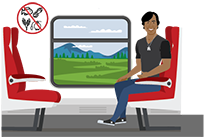
Chayton’s train seat is located far away from potential sources of his severe allergy, and passengers in that area are instructed to avoid products that could trigger his allergy. |
| Make aircraft, trains, ferries, buses, and terminals accessible by complying with specific technical requirements. | 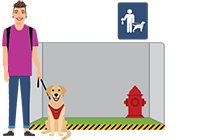
Dani’s seizure alert dog has a conveniently located service dog relief area at terminals when needed. |
| Make security screening services more accessible by having knowledgeable security officers at terminals to help travellers with disabilities. | 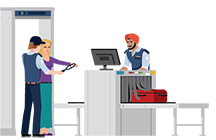
Elise can use a special faster line when she goes through airport security to reduce her severe pain when waiting in line. |
Source: Based on requirements from the Accessible Transportation for Persons With Disabilities Regulations
1.8 The Accessible Transportation for Persons With Disabilities Regulations do not address all barriers that travellers with disabilities could face, as some requirements apply only to new or renovated infrastructure (such as terminal buildings) or fleets (planes, trains, ferries, and buses).
1.9 To further progress toward a barrier‑free Canada for travellers with disabilities, complementary regulations, called the Accessible Transportation Planning and Reporting Regulations, require that transportation service providers consult with persons with disabilities to develop accessibility plans and that they report regularly on these plans (Exhibit 1.3).
Exhibit 1.3—The Accessible Transportation Planning and Reporting Regulations require transportation service providers to develop accessibility plans
The Accessible Transportation Planning and Reporting Regulations follow the Accessible Canada Act framework. They set out requirements for accessibility plans, feedback, and progress reports to work toward a barrier‑free Canada.
Purpose of accessibility plans
Accessibility plans set out how the transportation service providers will identify, remove, and prevent barriers. Accessibility plans are mandatory.
Timelines
Crown corporations—such as VIA Rail and the Canadian Air Transport Security Authority—must publish their initial plans by 31 December 2022. This is followed by annual reporting and plan updates every 3 years. Other transportation service providers must do the same under different timelines.
Consultation
Persons with disabilities must be consulted as accessibility plans and reports are developed.
Consultations are essential to eliminate existing barriers and prevent the introduction of others.
Feedback
Transportation service providers must have a process that continuously accepts and acknowledges feedback in various forms.
Source: Based on requirements from the Accessible Transportation Planning and Reporting Regulations
1.10 The 3 organizations we examined have different responsibilities regarding accessible transportation for persons with disabilities. VIA Rail Canada incorporatedInc. and the Canadian Air Transport Security Authority are 2 Crown corporations that deliver transportation services, including to passengers with disabilities. Under the relevant acts and regulations, the services they offer must meet existing accessibility requirements and be further improved to achieve barrier‑free transportation by 2040. The Canadian Transportation Agency is the regulator responsible for the oversight of the accessibility regulations for the transportation industry.
1.11 VIA Rail Canada Inc. (VIA Rail). This corporation provides intercity rail services and rail transportation services to regional and remote communities. It strives to be Canada’s most accessible national and intercity mode of transportation and accounts for more than 97% of passenger rail traffic in Canada.
1.12 Canadian Air Transport Security Authority. This corporation is responsible for securing elements of the air transportation system—including security screening passengers, baggage, and airport workers. The corporation interacts with passengers departing on commercial flights from designated airports in Canada as required by Transport Canada. The services the corporation offers to passengers with disabilities are specific to the situation and needs of the person. They include prioritizing access to the security screening on request and providing assistance during the screening. Assistance can include elements such as providing additional verbal or visual instructions; providing mobility aids, such as a cane; and handling heavy or bulky items.
1.13 Canadian Transportation Agency. This agency provides oversight as an independent, quasi‑judicial tribunal and regulator for transportation service providers covered by the federal transportation system. It is responsible for protecting the right of persons with disabilities to accessible transportation by
- establishing and implementing regulations and codes of practice
- providing guidance material
- enforcing regulations
- resolving individual complaints about accessibility
The agency also monitors and enforces the requirements of the Accessible Transportation for Persons With Disabilities Regulations and the Accessible Transportation Planning and Reporting Regulations. It also enforces the Accessible Canada Act for federally regulated transportation service providers.
Focus of the audit
1.14 This audit focused on whether VIA Rail, the Canadian Air Transport Security Authority, and the Canadian Transportation Agency identified and removed existing barriers and worked toward preventing transportation barriers for persons with disabilities.
1.15 This audit is important because all Canadians have the right to fully participate in society, regardless of their abilities. The federal government has committed, nationally and internationally, to leading by reducing barriers to transportation for persons with disabilities. This commitment aligns with the government’s commitment to the United Nations’ Sustainable Development Goals, which pledge to leave no one behind.
1.16 More details about the audit objective, scope, approach, and criteria are in About the Audit at the end of this report.
Findings and Recommendations
VIA Rail and the Canadian Air Transport Security Authority undertook consultations with persons with disabilities for some projects
1.17 This finding matters because engaging persons with disabilities and their representative groups is a key part of shifting attitudes and eliminating stigma. Persons with disabilities can share their direct experiences of the challenges they face, which can support full and equal access to transportation. Through meaningful, accessible, and inclusive consultations, transportation service providers can better understand how accessible their services are and where they need to improve.
1.18 Persons with disabilities must be consulted when transportation service providers develop accessibility plans. While there are no explicit regulatory requirements on how to consult with persons with disabilities, the United Nations, academia, the Canadian Transportation Agency, and others outline good practices on how to consult inclusively, accessibly, and meaningfully.
1.19 For example, an inclusive consultation approach is expected to include people with a variety of disabilities or people from representative groups. It is also expected to accommodate persons with disabilities with alternative means of communication and in an accessible venue to allow and encourage them to participate in the consultation. Moreover, knowledge gathered during the consultation should be considered, and the process should become a continuous dialogue.
Consultations occurred for the accessibility plans
1.20 We found that VIA Rail conducted an inclusive consultation process for its accessibility plan. The corporation consulted several organizations representing persons with disabilities and received substantial comments. However, subsequent actions and decisions were not well documented. We found that the corporation should have been able to better demonstrate how the input was considered.
1.21 We found that the Canadian Air Transport Security Authority opened an online consultation process with all Canadians regarding its accessibility plan in October 2022. The corporation also informed about a dozen organizations representing persons with disabilities of this open consultation, invited them to participate, and offered options to provide comments to make the consultation process accessible. We found that the corporation had a process to compile and consider the input received.
Consultations conducted for some other projects at VIA Rail
1.22 We found that VIA Rail conducted inclusive and accessible consultations for other projects for which consultations were not explicitly mandated by the accessibility regulations. One of these projects was the design of service dog relief areas, which were implemented at several train stations across the country. In 2018, VIA Rail also initiated a consultation process on the design development of its new train fleet for the Québec–Windsor corridor, which is used by most of VIA Rail’s passengers.
1.23 For the new train fleet design project, the corporation consulted persons with disabilities who faced various barriers, and it organized 5 consultative events throughout the project. It offered accommodations to address barriers that could prevent people from participating in the consultative process itself and presented updates to the design that resulted from the participants’ suggestions. Some of the implemented improvements included having wider doorways for accessible washrooms (Exhibit 1.4) and better signage.
Exhibit 1.4—VIA Rail’s new train fleet has a fully retractable wide door for the accessible washrooms
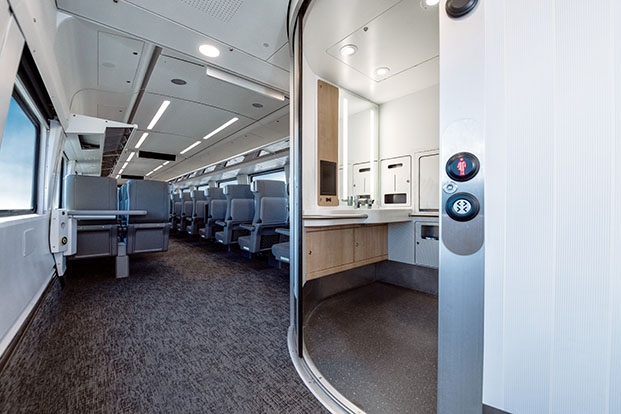
Photo: VIA Rail
1.24 Both projects demonstrated that the corporation was able to conduct consultations that aligned with good practices. However, we found that it had not consistently used this approach in its consultations for the design of its website and its accessibility training.
1.25 VIA Rail should identify strengths and areas for improvement based on its recent consultation experience with the new train fleet for the Québec–Windsor corridor to develop and conduct meaningful consultations and continuous dialogue with persons with disabilities to progress toward barrier‑free travel.
The corporation’s response. Agreed.
See Recommendations and Responses at the end of this report for detailed responses.
VIA Rail and the Canadian Air Transport Security Authority did not make their online information fully accessible
1.26 This finding matters because the first step in a traveller’s journey is often to gather information to plan and book travel. Complete, clear, and accessible online content helps to make the experience equitable for persons with disabilities.
1.27 Web accessibility means that persons with disabilities can fully understand, navigate, and interact with websites and online tools. It is measured by compliance with web accessibility standards—a set of criteria such as text alternatives for visual content, navigation functionality using a keyboard (for those who cannot use a mouse, for example), and readable and understandable text. The World Wide Web Consortium’s accessibility standards that transportation service providers must follow are organized around 4 principles (Exhibit 1.5).
Exhibit 1.5—Transportation service providers had to make their online information accessible by meeting web accessibility standards that cover 4 principles
Perceivable
The content can be perceived by users, no matter what senses they rely on. |
Understandable
The content is clear and concise, and users can explore it at their own pace. |
Operable
Users can easily navigate, find content, and determine where they are. |
Robust
Assistive technologies can reliably interpret content. |
Source: Adapted from the Web Content Accessibility Guidelines 2.0, published by the World Wide Web Consortium
Difficult user experience when planning or booking a trip
1.28 Using websites to make reservations or look for information was a barrier faced by 3 out of 10 travellers with disabilities, according to Statistics Canada’s Accessibility in Federal Sector Organizations Survey, 2021. It was one of the barriers in transportation that persons with disabilities most frequently experienced.
1.29 We used selected criteria from the web accessibility standards to examine parts of VIA Rail’s and the Canadian Air Transport Security Authority’s web and mobile sites. Web accessibility requires that all criteria be met. We found that neither corporation had fully accessible web and mobile sites.
1.30 We found that 17% (55 out of 333) of the online criteria tested at VIA Rail did not meet the required standards. The issues identified would have different effects depending on the user’s disabilities and on the information that was not accessible. For example, a person using a screen reader would get the wrong departure time. Some issues, however, were minor and would not affect travel.
1.31 We found that persons with disabilities were not consulted on the current online information layout at VIA Rail to ensure adherence to the 4 principles. We also found that online information about services to travellers in wheelchairs was not easy to find or understand. For example, people who use wheelchairs would have to click on each station on their trip to find out whether the station had an accessible washroom or a wheelchair lift. The same extensive web navigation had to be done to determine the services available on trains.
1.32 We found that 15% (35 out of 241) of the online criteria we tested at the Canadian Air Transport Security Authority did not meet the required standards. Most of the issues were due to missing alternative text descriptions. Some were minor, such as the description of images like the Canadian flag. However, other deficiencies could have a bigger impact, such as not informing the user of what to enter in a search field.
1.33 We also found that specific information on screening procedures and available accessibility services was hard to find on the Canadian Air Transport Security Authority’s website. For example, it was not clear what to expect during a security screening when travelling with a service dog. While this may not prevent a person with a disability from travelling, it can still be a barrier that adds to the stress and time required to travel.
1.34 VIA Rail and the Canadian Air Transport Security Authority should ensure that their online content meets web accessibility standards so that travellers with disabilities can easily find the information they need.
Response of each corporation. Agreed.
See Recommendations and Responses at the end of this report for detailed responses.
VIA Rail and the Canadian Air Transport Security Authority did not fully meet accessibility training requirements
1.35 This finding matters because accessibility training builds concrete skills so staff can provide appropriate assistance to persons with disabilities. It also helps improve awareness and understanding and remove unconscious biases when designing, delivering, and monitoring services. Decision makers and other personnel who have up‑to‑date skills can better respect the autonomy and dignity of all travellers, including persons with disabilities.
1.36 To ensure that training reflects the needs and realities of persons with disabilities, transportation service providers must consult with them when developing training programs and teaching methods, such as hands‑on or video‑based training. Specific elements that must be covered in all training programs according to the Accessible Transportation for Persons With Disabilities Regulations include
- key principles of accessibility
- how to communicate with persons with disabilities
- how to provide physical assistance
In addition, the regulations specify
- who should be trained (personnel who interact with the public, participate in making decisions, or develop policies or procedures)
- when the personnel should be trained (60 days after assuming a function)
- when personnel need refresher training (at least every 3 years)
Training content mostly complete
1.37 We found that VIA Rail had accessibility training programs for different groups of personnel, including staff working in call centres, service personnel working directly with travellers on the trains and in stations, and managers. Training programs for new employees were developed in light of the new regulations. A shorter program for current employees was developed to capture the differences between the training they received before the new regulations came into force and the new training offered to new employees. VIA Rail also created a new mandatory online training program for all members of management.
1.38 We examined the content of the training programs developed for different categories of personnel at VIA Rail. While many of the required training elements were included, we found that all of the programs had at least 1 gap. For example, there was no mention of the onboard electrical power supply in the accessibility training offered to client‑service staff. People using power‑assisted devices, such as electric wheelchairs or oxygen tanks, may need specific information, such as the location of outlets and their voltage and amperage. Staff need to be able to provide this information.
1.39 Security screening at airports is delivered on behalf of the Canadian Air Transport Security Authority by third‑party screening personnel. We found that the Canadian Air Transport Security Authority had included accessibility content in the training programs for these security screeners before the new regulations came into force. The corporation also developed mandatory online accessibility awareness training to help third‑party screening personnel be more aware of and sensitive to travellers’ needs and to help them learn how to facilitate the screening process for passengers with disabilities.
1.40 We examined the content of the training programs developed for the different categories of personnel at the Canadian Air Transport Security Authority. The programs included key mandatory elements with 1 notable exception: Third‑party screening personnel were not trained on the role of a support person. A support person may join a traveller with a disability to help with communication, mobility, or other needs. Third‑party screening personnel must understand this role to ensure that their interactions with both individuals are conducted with respect and dignity.
Incomplete consultation related to training
1.41 We found that VIA Rail did not consult persons with disabilities on the content of the training programs offered to its management. When it did consult on the training content for client‑service staff, the consultations did not fully meet good practices:
- There was only 1 way to provide feedback, which may have prevented some persons with disabilities from fully participating.
- The outcomes of the consultation (such as key actions or decisions taken) were not documented; therefore, we could not determine whether comments were used to improve training.
1.42 We also found that during VIA Rail’s consultation with persons with disabilities, participants were instructed not to provide feedback on the suggested training methods. Officials told us that this was done in order to focus the consultation on the training content. VIA Rail did not conduct additional consultations on the teaching methods.
1.43 The Canadian Air Transport Security Authority is prohibited from divulging security sensitive information that can be embedded in training related to screening procedures. Therefore, it was limited in the type and nature of consultative approach it could conduct on its training content. We found that the corporation was still able to get input from persons with disabilities and incorporated these views in training content. However, it did not seek input from persons with disabilities on the teaching methods.
Delayed uptake of accessibility training by management
1.44 Regulations require that transportation service provider staff and decision makers complete accessibility training within 60 days of their starting dates and take refresher training at least every 3 years. We used representative sampling to examine the training records of VIA Rail and Canadian Air Transport Security Authority personnel who were employed at any point in time between June 2020 and June 2022. We also examined a sample of training records of third‑party screening personnel who delivered services for the Canadian Air Transport Security Authority.
1.45 We found that 39% (9 out of 23) of managers and executives at VIA Rail had not completed training on time and 17% (4 out of 23) had not completed it at all. Training uptake by staff who interacted with clients was better (Exhibit 1.6).
1.46 We found that the Canadian Air Transport Security Authority did not initially realize that personnel involved in decision making needed to be trained until they were subject to a Canadian Transportation Agency compliance verification review. After getting clarification from the Canadian Transportation Agency about the training requirements for this category of employees in July 2021, the Canadian Air Transport Security Authority developed a corrective action plan with updated deadlines as directed by the Canadian Transportation Agency.
1.47 We also found that even with extended deadlines, there were additional delays in training uptake by managers and executives at the Canadian Air Transport Security Authority—almost a third completed their training late (Exhibit 1.6). Training uptake by third‑party screening personnel was higher.
Exhibit 1.6—A number of management personnel at VIA Rail and the Canadian Air Transport Security Authority who were employed at any time between June 2020 and June 2022 did not complete required accessibility training on time
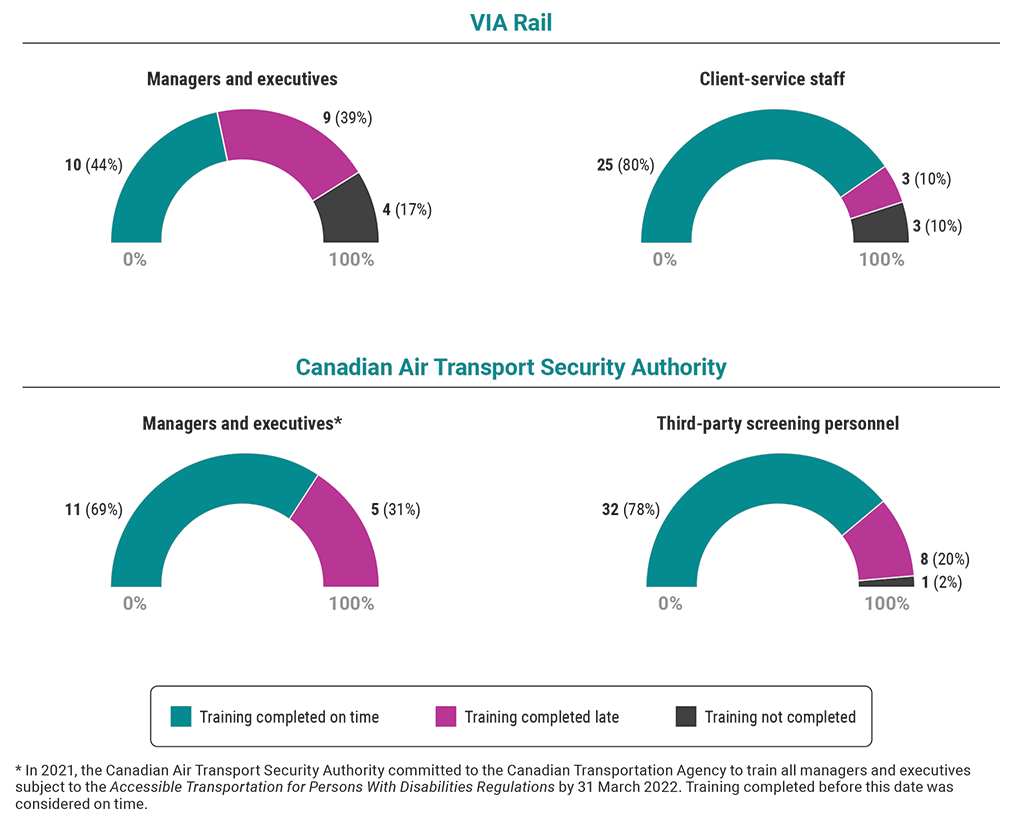
Source: Based on information provided by VIA Rail and the Canadian Air Transport Security Authority
Exhibit 1.6—text version
These 4 half pie charts show the number of management and other personnel at VIA Rail and the Canadian Air Transport Security Authority who completed accessibility training on time, completed it late, or did not complete it.
For managers and executives at VIA Rail, 10 (or 44%) completed the training on time, 9 (or 39%) completed it late, and 4 (or 17%) did not complete it.
However, for client‑service staff at VIA Rail, 25 (or 80%) completed the training on time, 3 (or 10%) completed it late, and 3 (or 10%) did not complete it.
For managers and executives at the Canadian Air Transport Security Authority, 11 (or 69%) completed the training on time and 5 (or 31%) completed it late. In 2021, the Canadian Air Transport Security Authority committed to the Canadian Transportation Agency to train all managers and executives subject to the Accessible Transportation for Persons With Disabilities Regulations by 31 March 2022. Training completed before this date was considered on time.
For third‑party screening personnel at the Canadian Air Transport Security Authority, 32 (or 78%) completed the training on time, 8 (or 20%) completed it late, and 1 (or 2%) did not complete it.
1.48 We found that VIA Rail made accessibility training mandatory for all management employees. The Canadian Air Transport Security Authority recommended accessibility training for all management employees, but it was mandatory only for those directly involved with accessibility. While this may go beyond the minimum requirements of the accessibility regulations, in our view, all management employees should take the training to improve their awareness of and capacity to address barriers affecting persons with disabilities and to lead by example.
1.49 VIA Rail should
- develop content to address gaps in its accessibility training programs, in consultation with persons with disabilities
- consult persons with disabilities on the teaching methods and on accessibility-related content updates
- ensure that personnel is trained, and in a timely manner, to improve their awareness of and capacity to address transportation barriers affecting persons with disabilities
The corporation’s response. Agreed.
See Recommendations and Responses at the end of this report for detailed responses.
1.50 The Canadian Air Transport Security Authority should
- develop accessibility training content, in consultation with persons with disabilities, related to the role of a support person
- consult persons with disabilities on the teaching methods and on accessibility-related content updates
- ensure that personnel is trained in a timely manner, to improve their awareness of and capacity to address transportation barriers affecting persons with disabilities
The corporation’s response. Agreed.
See Recommendations and Responses at the end of this report for detailed responses.
The Canadian Transportation Agency’s monitoring of new regulations did not sufficiently contribute to reducing barriers
1.51 This finding matters because persons with disabilities have the right to accessible transportation. The goal of the Accessible Transportation for Persons With Disabilities Regulations is to provide a more accessible transportation network. Monitoring and enforcing these regulations help eliminate preventable barriers.
1.52 As the regulator, the Canadian Transportation Agency is responsible for overseeing and monitoring the accessibility regulations for the transportation industry under federal jurisdiction. With this role, the agency contributes to the United Nations’ Sustainable Development Goal 10 (Reduce Inequalities) and target 10.3, which is to ensure equal opportunity and reduce inequalities of outcome.
1.53 The agency is responsible for monitoring compliance with the Accessible Transportation for Persons With Disabilities Regulations, which contain more than 450 enforceable provisions for more than 130 transportation service providers. The agency was also responsible for an increasing number of provisions and regulations that were outside the scope of this audit.
Limited types and number of inspections
1.54 We found that due to the coronavirus disease (COVID‑19)Definition 1 pandemic, the Canadian Transportation Agency relied mostly on virtual inspections to identify accessibility barriers. The types and numbers of barriers that this approach could identify were limited. However, we found that the agency was able to identify a number of barriers and help the transportation service providers address them.
1.55 The agency selected transportation service providers for inspection on the basis of volume of travel and its internal knowledge of risks. Criteria included information about the number of complaints filed at the agency against those providers. The agency also selected provisions of the Accessible Transportation for Persons With Disabilities Regulations for initial verification of compliance. They chose provisions that came into force in 2020 and conducted inspections using questionnaires and supporting evidence.
1.56 We found that from June 2020 to May 2022, the agency conducted 1 on‑site inspection at an airport and 47 virtual inspections of transportation service providers—specifically of air‑travel (22), rail (15), ferry (9), and bus (1) services. Agency officials told us that under typical conditions, a mix of both virtual and on‑site inspections would be conducted. We noted that the agency planned 44 on‑site inspections for the remainder of the 2022–23 fiscal year.
1.57 We examined the findings from the Canadian Transportation Agency’s inspections for a judgmental sample of 14 transportation service providers. We found that from April 2021 to August 2022, the agency identified a number of barriers and worked with the transportation service providers to remove some of these barriers (Exhibit 1.7). We noted that the agency was following up with transportation service providers on other cases to ensure that they removed the outstanding barriers identified.
Exhibit 1.7—The Canadian Transportation Agency identified barriers for travellers with disabilities
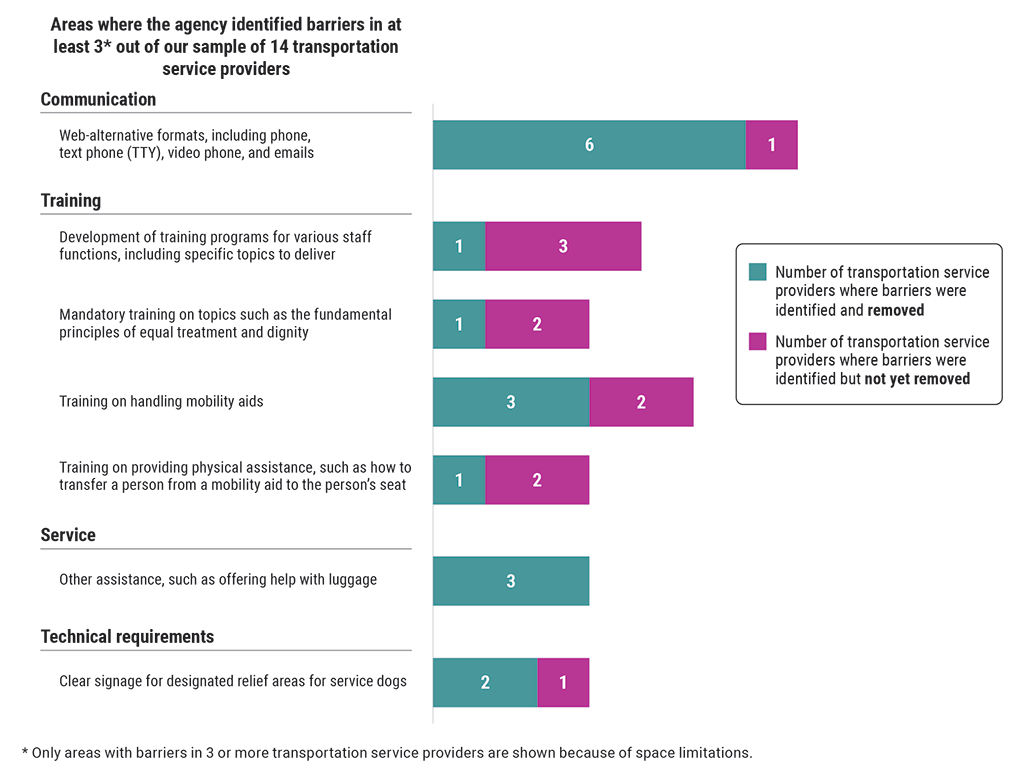
Source: Based on data from the Canadian Transportation Agency’s inspection files
Exhibit 1.7—text version
This bar chart shows the barriers for travellers with disabilities identified by the Canadian Transportation Agency. The chart shows areas where the agency identified barriers in at least 3 out of our sample of 14 transportation service providers. Only areas with barriers in 3 or more transportation service providers are shown because of space limitations.
The first area was communication, under which 1 type of barrier was identified by the agency. This type of barrier was web‑alternative formats, including phone, text phone (TTY), video phone, and emails. The barrier was identified and removed in 6 transportation service providers, but it was identified and not yet removed in 1 additional transportation service provider.
The next area was training, under which 4 types of barriers were identified by the agency:
- The first barrier under this area was the development of training programs for various staff functions, including specific topics to deliver. This barrier was identified and removed in 1 transportation service provider, but it was identified and not yet removed in 3 additional transportation service providers.
- The second type of barrier under this area was mandatory training on topics such as the fundamental principles of equal treatment and dignity. This barrier was identified and removed in 1 transportation service provider, but it was identified and not yet removed in 2 additional transportation service providers.
- The third type of barrier under this area was training on handling mobility aids. This barrier was identified and removed in 3 transportation service providers, but it was identified and not yet removed in 2 additional transportation service providers.
- The fourth type of barrier under this area was training on providing physical assistance, such as how to transfer a person from a mobility aid to the person’s seat. This barrier was identified and removed in 1 transportation service provider, but it was identified and not yet removed in 2 additional transportation service providers.
The next area was service, under which 1 type of barrier was identified by the agency. This type of barrier was other assistance, such as offering help with luggage. The barrier was identified and removed in 3 transportation service providers. There were no additional transportation service providers where the barrier was identified and not yet removed.
The last area was technical requirements, under which 1 type of barrier was identified by the agency. This type of barrier was clear signage for designated relief areas for service dogs. The barrier was identified and removed in 2 transportation service providers, but it was identified and not yet removed in 1 additional transportation service provider.
1.58 The agency must monitor services that are offered on demand, such as assistance with wheelchairs or requests for a buffer zone for allergens. We found that the virtual and on‑site inspections looked at how services were designed, in accordance with the regulations, but they did not test the actual service delivery. As a result, the agency did not determine the consistency and quality of the transportation service providers’ on‑demand services.
1.59 We also found that the agency had only 4 full‑time‑equivalent employees who supported the enforcement program related to accessible transportation to cover all of Canada. Given the geographical considerations and the high volume of regulatory requirements that apply, it is our view that this was not sufficient to monitor the multiple transportation service providers, including the more than 70 terminals located across the country.
1.60 Although the Canadian Transportation Agency was not required to report on the Sustainable Development Goals, we found that one of its performance indicators aligned with Goal 10 (Reduced Inequalities). The agency reported on the percentage of compliance with accessibility requirements and codes of practices (Exhibit 1.8). While the target was not achieved in the 2019–20 fiscal year, the agency subsequently reported that all non‑compliance was corrected within the required 70-day follow‑up period.
Exhibit 1.8—The Canadian Transportation Agency reported results on accessible transportation services for persons with disabilities
| Performance indicator | Target | Results achieved by the 2019–20 fiscal year | Results achieved by the 2020–21 fiscal year |
|---|---|---|---|
| Percentage of air, rail, and marine carriers and facility operators complying with accessibility-related legislative and regulatory requirements and codes of practice | At least 80% | 69% | Data not available because of the COVID‑19 pandemic (too few inspections) |
Source: Adapted from the Canadian Transportation Agency’s departmental results reports
1.61 The Canadian Transportation Agency should increase its capacity to identify accessibility barriers and enforce their removal by
- implementing additional oversight approaches, such as direct observations of available services to capture the actual experience of travellers with disabilities
- reviewing and adjusting its enforcement staffing level
The agency’s response. Agreed.
See Recommendations and Responses at the end of this report for detailed responses.
The organizations did not leverage complaint data to prevent barriers to accessibility
1.62 This finding matters because persons with disabilities directly voice concerns about the services, equipment, or behaviours they experienced when submitting a complaint. Analyzing complaint information helps provide a richer, more complete picture of a person’s experience of barriers so they can be addressed.
1.63 A Federal Data and Measurement Strategy for Accessibility 2022 to 2027 identifies complaints from the transportation sector as an untapped data source for actions to improve accessibility. One of the strategy’s guiding data principles is intersectionality—how different aspects of a person’s identity can affect the way the person experiences barriers to inclusion. This principle aligns with gender‑based analysis plusDefinition 2, the Government of Canada’s tool to assess systemic inequalities.
1.64 VIA Rail and the Canadian Air Transport Security Authority have their own complaint systems. As the regulator, the Canadian Transportation Agency expects travellers to first try to resolve their problems directly with the transportation service providers. If the issue cannot be resolved at that level, travellers can also file a complaint with the agency. The agency’s approach for dispute resolution includes facilitation, mediation, and adjudication.
Limited analysis and categorization of data at VIA Rail and the Canadian Air Transport Security Authority
1.65 Overall, we found that both VIA Rail and the Canadian Air Transport Security Authority missed opportunities to gain insights on the travel experiences of persons with disabilities by not conducting a more thorough analysis of available complaint data.
1.66 We found that VIA Rail handled complaint cases individually to address barriers to accessibility whenever possible. However, it did not analyze available complaint data as a whole to detect patterns and gain a more in‑depth understanding of the barriers faced by persons with different types of disabilities.
1.67 Similarly, we found that the Canadian Air Transport Security Authority also handled complaint cases individually to address barriers whenever possible. However, complaints were categorized by their nature and not by the status of the person. For example, a complaint about the screening of a service dog was considered as a complaint related to a security screening procedure rather than as a complaint related to a person with a disability.
1.68 We examined all complaints received by the Canadian Air Transport Security Authority from April 2017 to June 2022 and found 83 complaints categorized under persons with disabilities. We also found more than 1,000 complaints categorized elsewhere that included terms related to a disability, such as “mobility devices,” “service dogs,” and “autism.” Recognizing that these complaints may not all have been made by persons with disabilities or been directly related to disabilities, we examined a subset of these complaints and found that 73% (29 out of 40) were related to a person with a disability. The corporation’s categorization of complaint data limited its ability to analyze the data to identify long‑term issues.
1.69 VIA Rail and the Canadian Air Transport Security Authority should each develop and implement a strategy to improve their analysis of complaint data to get a more complete picture of barriers experienced by persons with disabilities. Each strategy should be developed in consultation with persons with disabilities and align with A Federal Data and Measurement Strategy for Accessibility 2022 to 2027.
Response of each corporation. Agreed.
See Recommendations and Responses at the end of this report for detailed responses.
Lack of access to complaint data for the Canadian Transportation Agency
1.70 The Canadian Transportation Agency does not have the authority to require transportation service providers to regularly provide complaint data on accessibility. It can do so only in limited and specific circumstances. We found that this limited its ability to fully understand the total number and nature of complaints and thus identify and address potential barriers to accessible transportation.
1.71 For example, when a wheelchair is damaged, a complaint can be lodged with the transportation service provider and, if necessary, with the agency. However, when complaints are submitted only to the transportation service provider, the agency is not made aware. Therefore, it does not know the full extent of the issues faced by persons with disabilities. In contrast, Canadian airlines travelling to US destinations must report accessibility performance indicators, such as damages to mobility aids, to the US Department of Transportation.
1.72 Complaint data is one of the key sources of information that flags problems experienced by travellers with disabilities. Not having the authority to regularly access this information limits the agency’s ability to more strategically select the Accessible Transportation for Persons With Disabilities Regulations provisions to inspect. This creates an additional risk that the agency is not focusing its limited resources on the areas of highest risk and that barriers could remain.
1.73 The Canadian Transportation Agency should identify and pursue opportunities to gather descriptive information on the number and nature of accessibility complaints filed with transportation service providers to improve its knowledge of day‑to‑day experiences faced by persons with disabilities. The information should be used to improve the agency’s enforcement strategy and remove additional barriers.
The agency’s response. Agreed.
See Recommendations and Responses at the end of this report for detailed responses.
Conclusion
1.74 We concluded that VIA Rail identified, removed, and prevented some barriers, but others remained. The corporation conducted inclusive consultations to identify and remove barriers while designing its new fleet. However, it did not consistently consult persons with disabilities on other projects, which resulted in missed opportunities to address more barriers. In addition, its online information was not fully accessible, making it difficult for persons with disabilities to plan or book a trip autonomously.
1.75 We also concluded that the Canadian Air Transport Security Authority took steps to identify, remove, and prevent transportation barriers for persons with disabilities. The corporation conducted an open consultation on its accessibility plan and developed training programs. However, to work toward barrier‑free travel, improvements are still needed in important areas, such as improving the accessibility of online information.
1.76 Finally, we concluded that the Canadian Transportation Agency did not sufficiently contribute to identifying, removing, and preventing transportation barriers for persons with disabilities through its monitoring and enforcement activities of the new regulations. While the agency identified and contributed to removing certain barriers, there were limitations in the type and volume of inspections it could conduct to progress toward barrier‑free travel. The agency also lacked the authority to access complaint data from the transportation service providers to improve its oversight.
About the Audit
This independent assurance report was prepared by the Office of the Auditor General of Canada on the accessibility of transportation for persons with disabilities. Our responsibility was to provide objective information, advice, and assurance to assist Parliament in its scrutiny of the government’s management of resources and programs and to conclude on whether the measures to identify, remove, and prevent barriers to transportation for persons with disabilities complied in all significant respects with the applicable criteria.
All work in this audit was performed to a reasonable level of assurance in accordance with the Canadian Standard on Assurance Engagements (CSAE) 3001—Direct Engagements, set out by the Chartered Professional Accountants of Canada (CPA Canada) in the CPA Canada Handbook—Assurance.
The Office of the Auditor General of Canada applies the Canadian Standard on Quality Management 1—Quality Management for Firms That Perform Audits or Reviews of Financial Statements, or Other Assurance or Related Services Engagements. This standard requires our office to design, implement, and operate a system of quality management, including policies or procedures regarding compliance with ethical requirements, professional standards, and applicable legal and regulatory requirements.
In conducting the audit work, we complied with the independence and other ethical requirements of the relevant rules of professional conduct applicable to the practice of public accounting in Canada, which are founded on fundamental principles of integrity, objectivity, professional competence and due care, confidentiality, and professional behaviour.
In accordance with our regular audit process, we obtained the following from entity management:
- confirmation of management’s responsibility for the subject under audit
- acknowledgement of the suitability of the criteria used in the audit
- confirmation that all known information that has been requested, or that could affect the findings or audit conclusion, has been provided
- confirmation that the audit report is factually accurate
Audit objective
The objective of this audit was to determine whether VIA Rail, the Canadian Air Transport Security Authority, and the Canadian Transportation Agency identified and removed existing barriers and worked toward preventing transportation barriers for persons with disabilities.
Scope and approach
The audit looked at whether VIA Rail and the Canadian Air Transport Security Authority delivered accessible transportation services as required by the Accessible Transportation for Persons With Disabilities Regulations. In addition, the audit looked at whether these 2 Crown corporations used a systematic and proactive approach to remove barriers by developing their plans as required by the Accessible Transportation Planning and Reporting Regulations.
The audit also looked at whether the Canadian Transportation Agency’s administration and enforcement of the Accessible Transportation for Persons With Disabilities Regulations and the agency’s management of its related dispute services were effective in ensuring that transportation service providers delivered accessible transportation for persons with disabilities.
In addition, the scope of the audit also included whether the 3 organizations considered gender‑based analysis plus and addressed the United Nations’ Sustainable Development Goal 10 (Reduced Inequalities) related to identifying, removing, and preventing transportation barriers for persons with disabilities.
Audit methodology included interviews with agency and corporation officials, document reviews, and data analysis. We also interviewed stakeholders from the transportation industry and groups representing persons with disabilities. External advisors to the audit included persons with disabilities.
The definitions for barrier and disability used in the report are from the Accessible Canada Act and the Canada Transportation Act:
barrier means anything—including anything physical, architectural, technological or attitudinal, anything that is based on information or communications or anything that is the result of a policy or a practice—that hinders the full and equal participation in society of persons with an impairment, including a physical, mental, intellectual, cognitive, learning, communication or sensory impairment or a functional limitation.
disability means any impairment, including a physical, mental, intellectual, cognitive, learning, communication or sensory impairment—or a functional limitation—whether permanent, temporary or episodic in nature, or evident or not, that, in interaction with a barrier, hinders a person’s full and equal participation in society.
We examined selected requirements of the Accessible Transportation for Persons With Disabilities Regulations. We also used samples or full population analysis in our examination of personnel training, online compliance, complaints, and inspections:
- Personnel training. We used representative sampling to examine the training records of staff and third‑party screening personnel who were required to take training in order to determine whether they had completed the courses on accessibility on time. We complemented this sample with a review of the training records of all senior executives. Where representative sampling was used, samples were sufficient in size to conclude whether or not the likely non‑compliance in the sampled population exceeded 10% (that is, the margin of error) with a confidence level of 90%.
- Online compliance to accessibility standards. We examined online information from VIA Rail and the Canadian Air Transport Security Authority against 23 criteria for websites and 19 criteria for mobile applications that were derived from the Web Content Accessibility Guidelines 2.0, as required in the Accessible Transportation for Persons With Disabilities Regulations. To assess the accessibility of online information, we used various manual and automated testing methods, including different screen readers.
- Complaints. We examined all complaints received from April 2021 to June 2022 by the 3 organizations.
- The Canadian Transportation Agency’s inspections. We examined the agency’s records of inspections and findings for 14 selected transportation service providers.
We did not examine
- international travel and border screening
- decisions by the Canadian Transportation Agency as a quasi‑judicial tribunal
Criteria
We used the following criteria to conclude against our audit objective:
| Criteria | Sources |
|---|---|
|
VIA Rail and the Canadian Air Transport Security Authority seek and use input from persons with disabilities to identify and remove existing barriers and work toward preventing transportation barriers for persons with disabilities. |
|
|
VIA Rail and the Canadian Air Transport Security Authority put in place selected requirements of the Accessible Transportation for Persons With Disabilities Regulations. |
|
|
The Canadian Transportation Agency effectively monitors selected requirements of the Accessible Transportation for Persons With Disabilities Regulations to remove accessibility-related barriers to transportation. |
|
|
The Canadian Transportation Agency removes accessibility barriers by following up on non‑compliance issues and on enforcement actions taken. |
|
|
VIA Rail, the Canadian Air Transport Security Authority, and the Canadian Transportation Agency’s accessibility complaints processes are easy to use, and complaints are resolved in a timely manner and reported appropriately. |
|
|
VIA Rail, the Canadian Air Transport Security Authority, and the Canadian Transportation Agency use complaints made by persons with disabilities to identify, remove, and prevent barriers to accessible transportation. |
|
Period covered by the audit
The audit covered the period from 25 June 2020 to 30 October 2022. This is the period to which the audit conclusion applies. However, to gain a more complete understanding of the subject matter of the audit, we also examined certain matters that preceded the start date and succeeded the end date of this period:
- Resolving complaints covered the period from 1 April 2017 to 30 June 2022.
- The Accessible Transportation Planning and Reporting Regulations extended to 31 December 2022.
Date of the report
We obtained sufficient and appropriate audit evidence on which to base our conclusion on 23 January 2023, in Ottawa, Canada.
Audit team
This audit was completed by a multidisciplinary team from across the Office of the Auditor General of Canada led by Milan Duvnjak, Principal. The principal has overall responsibility for audit quality, including conducting the audit in accordance with professional standards, applicable legal and regulatory requirements, and the office’s policies and system of quality management.
Recommendations and Responses
In the following table, the paragraph number preceding the recommendation indicates the location of the recommendation in the report.
| Recommendation | Response |
|---|---|
|
1.25 VIA Rail should identify strengths and areas for improvement based on its recent consultation experience with the new train fleet for the Québec–Windsor corridor to develop and conduct meaningful consultations and continuous dialogue with persons with disabilities to progress toward barrier‑free travel. |
VIA Rail’s response. Agreed. VIA Rail does see value in the recommendation made by the current report and will build on its recent consultation experience with the new Corridor fleet to develop and conduct meaningful and inclusive consultations with persons with disabilities to progress toward barrier‑free travel. The next project on which VIA Rail will consult is the new long‑haul fleet. This (these) consultation(s) will take place during 2023. VIA Rail will pursue its consultations with persons with disabilities as new projects come along. |
|
1.34 VIA Rail and the Canadian Air Transport Security Authority should ensure that their online content meets web accessibility standards so that travellers with disabilities can easily find the information they need. |
VIA Rail’s response. Agreed. VIA Rail will ensure that its online content meets web accessibility standards by having its web and mobile sites reviewed once a year by a web accessibility specialist and will correct the gaps in the sites accordingly. VIA Rail might have to ask for additional funding in order to comply with this recommendation. As VIA Rail is undergoing the modernization of its various key information technology support systems, including its reservation system and web page content, it will ensure a better flow of information as such modernization occurs. For instance, VIA Rail has consulted American Sign Language and la langue des signes québécoise (Quebec Sign Language) users to create videos explaining the reservation process in sign language. These videos will also have subtitles in English and French and will be embedded in the new reservation system. Our viarail.ca/en web page is also undergoing continuous improvements as VIA Rail launches its modernization initiatives. The first improvements are scheduled to occur in summer 2023, and at that time, VIA Rail will consult with persons with disabilities with the intent to follow Web Content Accessibility Guidelines (WCAG) norms at all times. We are continuously committed to updating our websites with content making sure we meet the WCAG norms at all times. The Canadian Air Transport Security Authority’s response. Agreed. The Canadian Air Transport Security Authority acknowledges that its online content needs to fully meet web accessibility standards. As shared with the Office of the Auditor General of Canada, the Canadian Air Transport Security Authority’s current website content management system (CMS) is outdated and does not allow some noted deficiencies to be addressed. The transition to an updated version of the CMS has been underway since September 2022, with an estimated completion date of February 2023. At that time, the Canadian Air Transport Security Authority’s plan to meet all web accessibility standards will be initiated with a target for full compliance by March 2024. |
|
1.49 VIA Rail should
|
VIA Rail’s response. Agreed. VIA Rail has put in place a stringent follow‑up on training its executive and management staff to ensure training completion within 60 days. Every month, VIA Rail does a validation of employees who have not completed the training, and an email is sent to inform the person that they must do the training within 60 days. Current management training material will be reviewed in collaboration with persons with disabilities in 2023. The timeline for this depends on the availabilities of our partners from advocacy groups. The review will address any gaps and incorporate any proposed teaching methods for training of both unionized employees and management when applicable. |
|
1.50 The Canadian Air Transport Security Authority should
|
The Canadian Air Transport Security Authority’s response. Agreed. The Canadian Air Transport Security Authority’s training development team will develop additional content relating to the role of the support person, in consultation with persons with disabilities. This content will be incorporated into both the initial training program and refresher training for third‑party screening personnel, who will receive this updated content in 2023. With respect to the teaching methods, the Canadian Air Transport Security Authority will develop a consultation strategy that respects the regulatory constraints surrounding the disclosure of security sensitive content and will conduct the consultation with persons with disabilities by 31 December 2023. With respect to training for its management, the Canadian Air Transport Security Authority expanded the list of management and decision makers required to receive disability awareness training and refreshers. A total of 43 managers are required to complete the training, 32 of which have completed it as of December 2022. The remaining 11 managers will complete the training by 31 March 2023. For third‑party screening personnel, pre‑certified screening officers are now required to complete the mandatory disability awareness training before they are permitted to exercise their duties. |
|
1.61 The Canadian Transportation Agency should increase its capacity to identify accessibility barriers and enforce their removal by
|
The Canadian Transportation Agency’s response. Agreed. The Canadian Transportation Agency will look into opportunities for designated enforcement officers to gather information more directly from persons with disabilities, such as educational walk‑throughs or shadowing persons with disabilities during parts of their travel experience, to better understand how services are being provided to them and will integrate this information into compliance and enforcement strategies, including those services provided upon request. To ensure these approaches have the broadest possible impact, the Canadian Transportation Agency will seek participants with a range of disabilities and from various locations across Canada and will continue to engage persons with disabilities in exploring other additional innovative approaches. The Canadian Transportation Agency will develop approaches in early 2023 and integrate them into the 2023–24 Compliance and Enforcement Work Plan to be piloted in late 2023 / early 2024. Should the Canadian Transportation Agency receive additional funding, the agency will reassess its staffing levels, including its enforcement complement. The Canadian Transportation Agency will raise the issue of funding through the appropriate government channels this fiscal year. Whether or not funding is received, the agency will utilize compliance risk profiles of transportation service providers and the analysis of Canadian Transportation Agency complaint data and feedback received, including from persons with disabilities, to efficiently allocate its resources in the 2023–24 Compliance and Enforcement Work Plan and beyond. |
|
1.69 VIA Rail and the Canadian Air Transport Security Authority should each develop and implement a strategy to improve their analysis of complaint data to get a more complete picture of barriers experienced by persons with disabilities. Each strategy should be developed in consultation with persons with disabilities and align with A Federal Data and Measurement Strategy for Accessibility 2022 to 2027. |
VIA Rail’s response. Agreed. VIA Rail commits to developing and implementing a strategy in 2023 to improve its analysis of complaint data in order to get a more complete picture of barriers experienced by clients with disabilities. This strategy will include producing a detailed quarterly accessibility complaints report for the Accessibility Team. This report will contain and already contains information related to the nature of complaints, identified root cause(s), and actions taken. VIA Rail also commits to continuing to promptly report (if and when identified) repeated issues to the Accessibility Team and impacted business units. The Canadian Air Transport Security Authority’s response. Agreed. The Canadian Air Transport Security Authority will develop and implement a strategy to improve its current analysis of complaint data as it relates to barriers experienced by persons with disabilities. The strategy will be developed in consultation with various teams within the Canadian Air Transport Security Authority, as well as persons with disabilities, and will be aligned with A Federal Data Measurement Strategy for Accessibility 2022 to 2027. Planning for the strategy development will commence by April 2023, with a targeted date for implementation of the strategy of September 2024. |
|
1.73 The Canadian Transportation Agency should identify and pursue opportunities to gather descriptive information on the number and nature of accessibility complaints filed with transportation service providers to improve its knowledge of day‑to‑day experiences faced by persons with disabilities. The information should be used to improve the agency’s enforcement strategy and remove additional barriers. |
The Canadian Transportation Agency’s response. Agreed. The Canadian Transportation Agency will seek opportunities to collect data from transportation service providers on the complaints that they receive from travellers. By March 2024, the Canadian Transportation Agency will explore the possibility of obtaining such data directly from transportation service providers on a voluntary basis. The Canadian Transportation Agency will also raise this issue through the appropriate governmental processes starting in 2023. |





